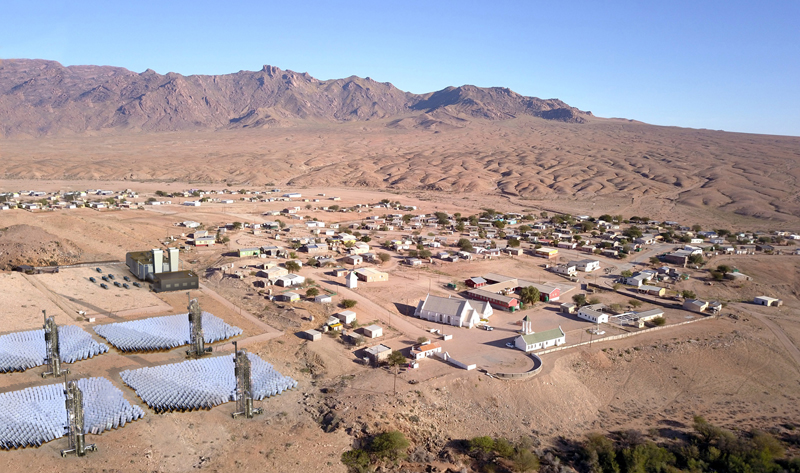How CSP Offers Unique Opportunities for Economic Development
 By: Bruce Anderson,
By: Bruce Anderson,
Founder and CEO – 247Solar, Inc.
Concentrated Solar Power (CSP) is emerging as a pivotal technology in the global transition to sustainable energy, offering a suite of socio-economic benefits that extend well beyond clean electricity generation. Particularly in developing countries and regions with abundant solar resources, CSP presents unique opportunities for job creation, local industrial development, and energy access—areas where conventional renewables such as solar photovoltaics (PV) and wind often fall short.
Job Creation
CSP projects generate significant employment across the entire value chain, from project planning through construction, operation, maintenance, and eventual decommissioning. According to a recent report form IRENA, the construction and operation of a 100 MW CSP plant with ten hours of thermal energy storage (TES) requires approximately 1.16 million person-days, distributed primarily across engineering, procurement, and construction (EPC) (46%), and operation and maintenance (O&M) (42%) activities[1]. Notably, 79% of these jobs require low- to medium-level technical skills, which are typically available or can be developed locally through vocational training or certification programs.

247Solar
This broad skills demand enables the inclusion of both skilled and semi-skilled workers, facilitating workforce transitions from fossil-fired power sectors—where similar skill sets are prevalent—to renewable energy. For example, IRENA found that in South Africa, over 70% of the CSP construction workforce are citizens, with 36% drawn from local communities, directly addressing unemployment and fostering inclusive economic growth. Moreover, O&M activities—critical for plant performance—are highly localizable, providing stable, long-term employment and opportunities for upskilling.
Local Manufacturing and Industrial Development
CSP’s value chain is uniquely suited to local content and industrial participation. Many system components—such as structural elements, mirrors, trackers, and pipes—can be manufactured domestically, leveraging existing industries like automotive and materials manufacturing. In South Africa, IRENA notes that 50–60% of the component value for large-scale CSP tower plants can be sourced locally, with domestic production of fundamental components representing roughly 10% of a plant’s value. This local manufacturing not only creates jobs but also stimulates the growth of ancillary industries, enhancing the overall industrial base and technological capabilities of host countries.
Policy instruments such as local content requirements (e.g., South Africa’s mandate that 40% of project value be sourced locally) further incentivize domestic manufacturing and procurement, amplifying the socio-economic benefits of CSP deployment. Such policies, when paired with targeted investment incentives and support for technology transfer, can catalyze the development of robust local supply chains and foster innovation ecosystems.
Energy Access and Reliability
CSP’s ability to provide clean, dispatchable power and heat is particularly valuable for communities and regions that are off-grid or connected to unreliable grids. Unlike PV and wind, CSP plants equipped with thermal energy storage can supply electricity and industrial-grade heat on demand, including during periods of low solar irradiance or at night. This capability is crucial for supporting economic activity in remote or underserved areas, where energy reliability is a prerequisite for development.
Moreover, CSP’s flexibility extends beyond electricity generation; it can deliver process heat for industrial applications, district heating, and even drive chemical processes for solar fuels—services that PV and wind cannot provide directly. For example, in Spain, CSP is increasingly recognized as a key contributor to industrial decarbonization, with solar heat for industrial processes (SHIP) systems being deployed in sectors such as agri-food, pasteurization, and steam production.
Deep Decarbonization and Dispatchability
While PV and wind have achieved remarkable cost reductions and deployment growth, their inherent variability limits their capacity to provide round-the-clock energy without external storage solutions. CSP, by contrast, integrates thermal energy storage as a core feature, enabling it to deliver dispatchable power and heat that can substitute for fossil-based generation in both electricity and industrial sectors. This makes CSP uniquely positioned to support deep decarbonization, especially where continuous or high-temperature energy is required.
Moreover, CSP’s reliance on abundant, non-critical materials and its lower dependence on hazardous or environmentally detrimental inputs further enhance its sustainability profile compared to PV (which relies on critical minerals) and wind (which requires large quantities of rare earth elements for turbines).
Not Your Father’s CSP
The CSP sector is undergoing a transformation from legacy large-scale installations to smaller, modular systems. These modular CSP units can be sited closer to end-users—such as industrial facilities, remote communities, or district heating networks—and can be scaled to meet specific local needs. This shift not only reduces transmission losses and infrastructure costs but also democratizes access to clean energy, making CSP viable in a broader range of geographical and economic contexts.
Modular CSP systems also lower barriers to entry for local firms and new market participants, enabling greater participation by small and medium-sized enterprises (SMEs) and fostering local entrepreneurship[1]. This evolution mirrors trends in PV but with the added advantage of dispatchable, high-temperature energy services.
Now More than Ever
CSP stands out among renewable technologies for its ability to create local jobs across a wide skills spectrum, stimulate domestic manufacturing, and provide reliable, clean energy and heat—benefits that are especially pronounced in developing countries with strong solar resources. Its inherent storage and dispatchability make it indispensable for deep decarbonization and energy system resilience. The advent of modular CSP systems further expands its relevance, enabling tailored solutions for diverse communities and industries. Now more than ever, CSP can serve as a cornerstone of inclusive, sustainable economic development in the global energy transition.
